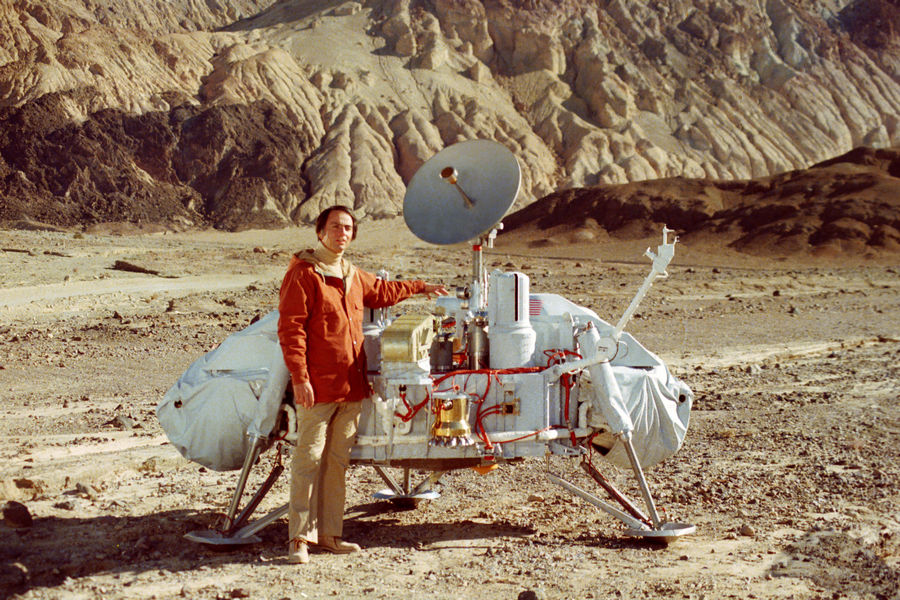 Karl Sagan at the layout of the descent vehicle
Karl Sagan at the layout of the descent vehicleIt has been 35 years since the mission of the four Vikings — 2 orbital stations and 2 descent vehicles — ended with an operator error leading to the descent of the Viking-1 descent antenna. This mission was the second to reach the surface of the “red planet” and the first truly successful (communication with
Mars-3 , which reached Mars surface 4.5 years earlier, broke off just 15 seconds later).
"Vikings" managed to work on the surface of Mars for 4 and 6 years instead of the planned 90 days, transmitting during this time information about the Martian climate at different times of the year from opposite ends of the planet, take a couple of 4.5 thousand surface photographs and conduct the first experiments on search for life. The orbital stations also worked 2 and 4 years instead of the planned 120 days, taking 700 and 1385 revolutions around Mars during this time and transmitting over 52 thousand photographs covering 97% of the Martian surface.
Constructions of devices
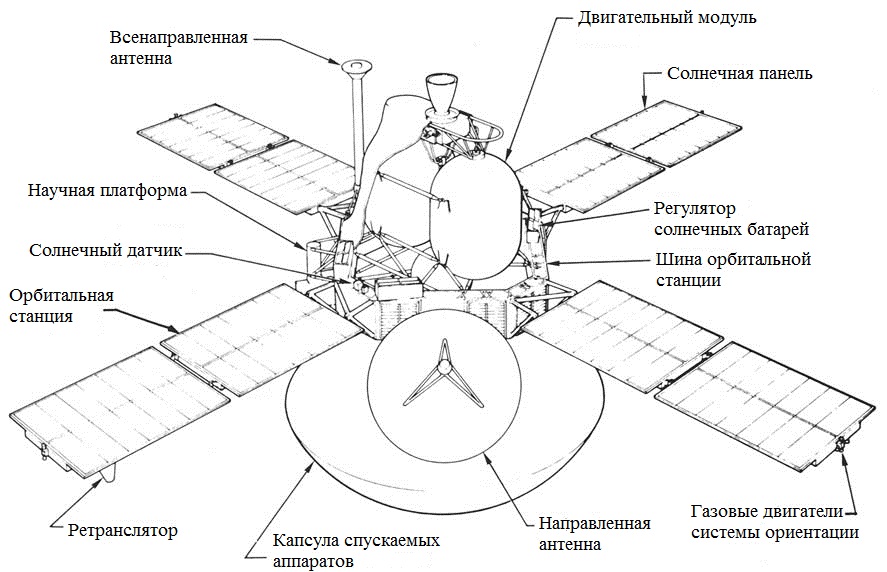
The orbital stations had the shape of an octagon with a diameter of 2.4 m and a height of 3.3 m with a span of solar panels of 9.7 m (their area had as much as 15 m
2 ). The weight of the station was 2325 kg, which included color cameras of visible and infrared light and water detectors. To power the equipment during the flight in the shadow of Mars, nickel-cadmium batteries were installed at the stations for 30
ampere hours .
An omnidirectional antenna was used to communicate with the Earth, a 1.5-meter directional diameter was used for Mars. The communication speed was 2-16 kbps for scientific data and only 8.3-33.3 bit / s for engineering (data on the state of the device itself). The stations also served as a repeater for descent vehicles at a communication speed of 4 kbit / s during their descent and 16 kbit / s during communication from the surface. To store the information, 2 tape recorders of 4.76 MB each were used.
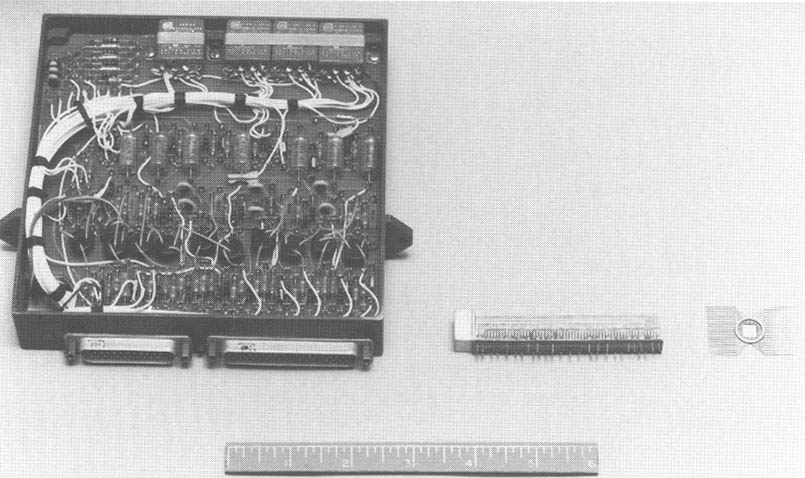 Electronic components "Vikings"
Electronic components "Vikings"The computers of both devices had 18 thousand memory cells on
cylindrical magnetic films , half of which accounted for instructions and data (read-only memory and rewritable memory, respectively). This computer later became the
Voyagers Command Computer (CCS), and its idea of completely duplicating components was to use when creating the other two of their computers.
 One of the memory boards "Vikings" on the shaker
One of the memory boards "Vikings" on the shakerThe creation of software for descent vehicles took place from July 1971 to June 1974 and required 2009 person-months of work to write 20 thousand of his words. Since it was decided to select the appropriate hardware after writing the code - “iron” was delivered just
2 months before the launch of the devices.
A retarding potential analyzer (for measuring the density of the atmosphere) and a mass spectrometer of the upper layers of the atmosphere were installed on the ablation shield discharged 3.5 meters in diameter. To control the descent, 12 small steering engines with 85 kg titanium tank of hydrazine one-component fuel were installed on it. The 50-pound drag parachute was made of polyester and was 16 meters in diameter.
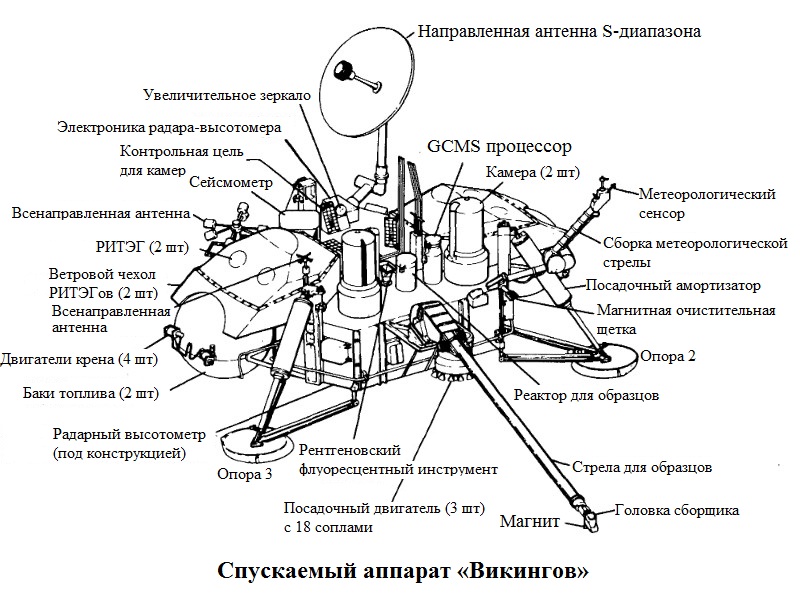
On the descent vehicles weighing 576 kg with a span of 2.21 meters between each of the 3 pillars, much more instruments were installed: black-and-white chambers, a mass spectrometer for a gas chromatograph, a seismometer, a fluorescent X-ray spectrometer, weather measurement, sampler and biological laboratory. For communication with stations in orbit and directly with the Earth, a directional 76-centimeter plate was used, and for receiving commands a non-antenna antenna was used. The devices were powered by 2
RTGs with plutonium-236 at 35 watts of power (the same used before on the
Pioneer-10 and
-11 ) and 4 nickel-cadmium batteries. To reduce the effect of contamination of soil samples at the landing sites, the 3 landing engines of the apparatus had 18 nozzles each and two 85 kg tanks feeding them. Three landing pillars of the apparatus had inside the aluminum honeycomb, which, with crumpling, extinguished the blow during landing.
The Viking program was established in September 1974, so in order to comply with
the space treaty (signed by the United States in 1967), according to which all countries that signed the treaty committed themselves to reduce to 1/1000 the chance of planets infecting by terrestrial organisms summer period, which began on January 1, 1969) —the Viking landing gears were placed in bioschites, after which their surface was sterilized at a temperature of 131 ° C with a duration sufficient for the chance of infecting the planet not to exceed 1/10000 by one apparatus (to the words Despite the fact that the Outer Space Treaty signed already
107 countries , a separate specialist position Planetary Defense have only
two organizations : NASA and ESA).
The course of the mission and its discoveries
The 11-month journey to Mars of two pairs of vehicles began from Cape Canaveral on August 20 and September 9, 1975 at the top of the Titan-IIIE launch vehicles with the Centaurus upper stage. After arriving at Mars, the vehicles were separated and the descent vehicle went into parking orbit while the station was taking pictures of a pre-selected landing site.
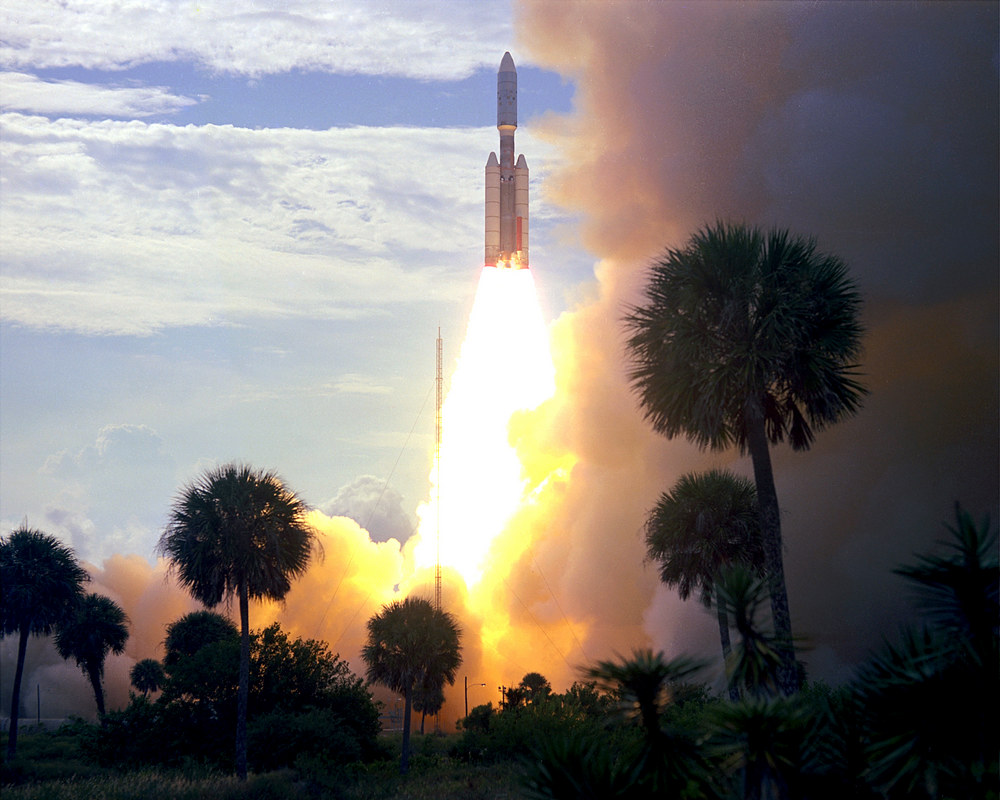 Viking Start-1
Viking Start-1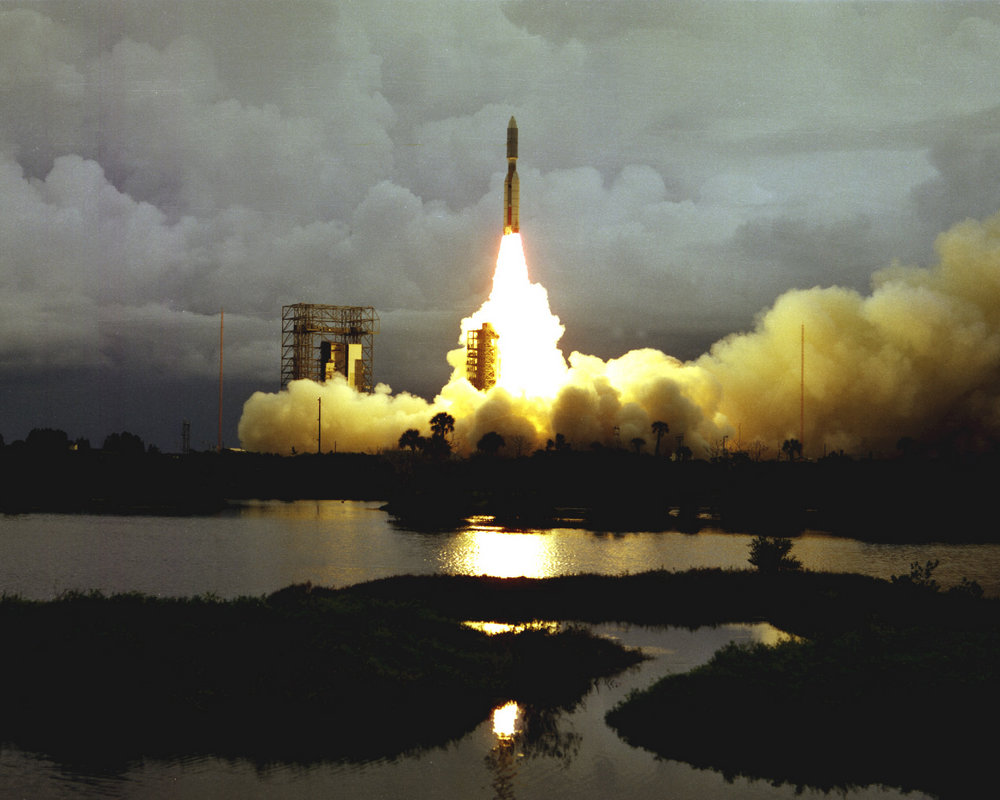 and Viking-2
and Viking-2Viking 1 arrived on Mars on June 19, 1976, and the landing was scheduled for July 4. However, in the pictures the landing site turned out to be too stony and it was decided to change it. As a result, a new landing site was searched for in the area previously scheduled for more than two weeks, so the lander landed without incident on the western slope of
Chris's plain but only by July 20. Already on August 7, a second pair of vehicles arrived at Mars with which the same story happened. This time, the search for a new place and the landing of the descent vehicle met the pre-scheduled time (by September 3), but it didn’t go without incident: the vehicle sat without damage on the
Utopia plain , but one of its 3 landing posts got on the stone, so that he stood from the beginning to the end of his work with an inclination of 8 ° relative to the horizon, which, however, had no effect on his scientific mission.
Video of the launch of the apparatus to Mars and the comments of the missionEven at the descent stage, in addition to the overwhelming volume of carbon dioxide (95%), the apparatus could also fix 1-2% argon with 2-3% nitrogen. At an altitude of 6 km, the parachute opened and the ablation shield was dropped, after braking the parachute was shot off and, at a height of 1.4 km, soft landing engines were activated. After planting, the apparatus took samples of the soil using a mechanical arm and added water and nutrient medium to them. Descent vehicles managed to fix the release of oxygen and carbon dioxide from samples, and after heating, in addition to a substantial proportion of silicon, iron, calcium, aluminum and titanium, samples of soil, carbon, hydrogen and phosphorus were found in soil samples.
In general, the results were disappointing: the content of organic substances in the soil was one per million (even lower than the lunar soil) and in addition to one result from 3 biological experiments (which was later found to be false-positive) and
“faces on Mars” (which, when taken subsequent missions in higher resolution turned out to be just a mountain) - no traces of life were found. As the biologists of the mission put it: “Mars turned out to be self-sterilized” due to ultraviolet radiation, dryness of the soil and processes of its oxidation (almost all the oxygen not bound in atmospheric carbon dioxide went to oxidize iron in the soil, which has a characteristic reddish content of 15% of iron oxides shade).
 "Martian face" when shooting with increased resolution by MRO
"Martian face" when shooting with increased resolution by MROOrbital stations were able to photograph a wide network of river channels that once flowed on Mars, which shifted further missions to Mars from the search for life at the moment, to search for traces of life that existed on the "red planet" earlier. In addition, they managed to clarify the mass of two Martian satellites: according to their density, it was only 2 times higher than the water density, which meant that Phobos and Deimos most likely formed in the asteroid belt and then were captured by the gravity of Mars. A rather funny story is connected with pictures from the surface of Mars: since the suspension of Martian dust scatters red light, in the evening (when the light has to pass a considerable thickness of the atmosphere) the red light is scattered and the sky becomes ... blue (as we have on Earth on day) caused real confusion in NASA: so the first picture with a blue sky was published on July 21, and on July 26, its version with a red sky (as it was considered corrected) was released.
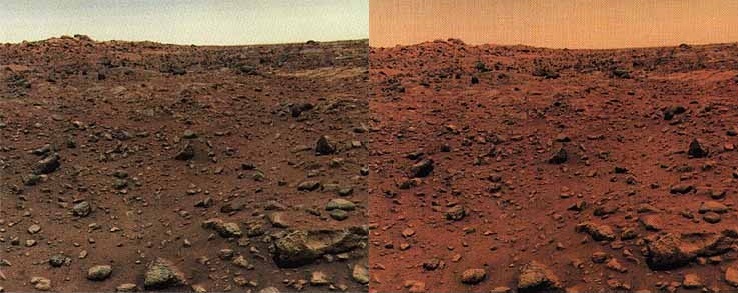
The first color image and its “corrected” version
The main mission of the Vikings ended on November 15, 1976, and by the 26th, Mars had begun to
connect with the Sun, during which communications were temporarily lost with the vehicles. Measurements of the moment of loss of communication with the devices allowed experimentally confirming the compliance of the deceleration of the signal in the gravitational field of a massive object (the Sun) with Einstein's theory with an accuracy
of 0.1% (20 times higher than that of all previous experiments). After Mars emerged from the shadow of the sun in mid-December, the already expanded Viking mission began.
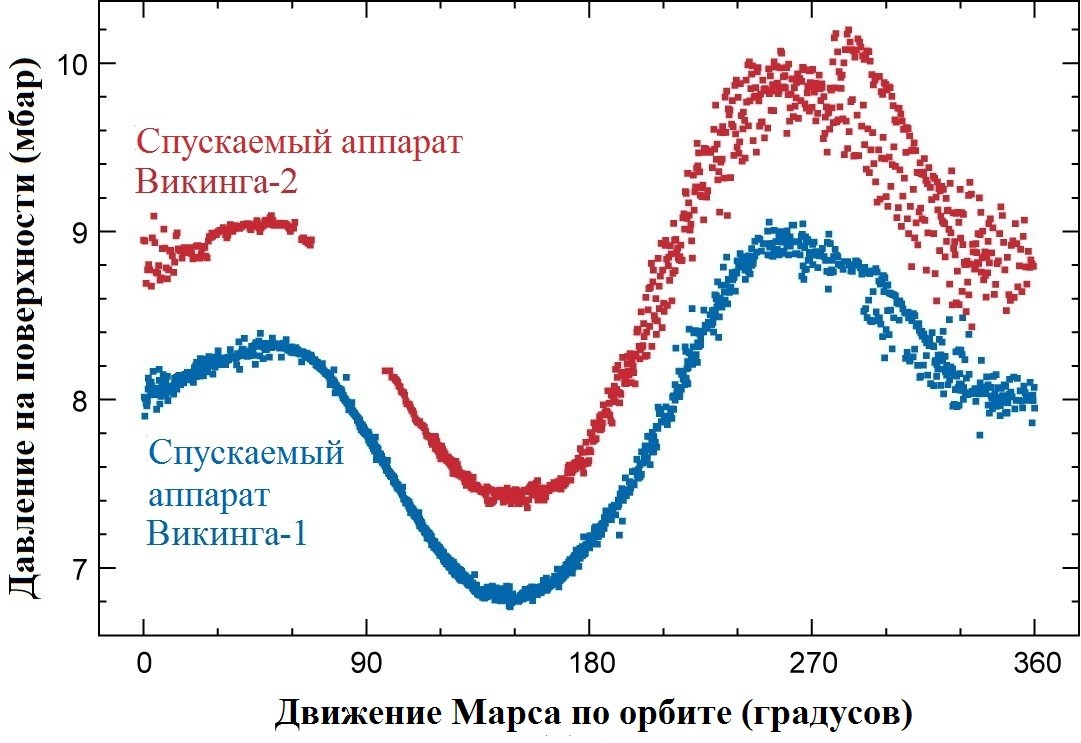
Data on the atmospheric pressure of the Viking-1 ranged between 6.8 and 9
mbar , while the Viking-2 was 7.3-10.8 mbar (the difference in pressure was caused by the fact that the Viking-2 sat at a point 900 meters below its counterpart ). Temperature differences ranged from -77 ° C to -14 ° C for Viking-1 and -120 ° C to 4 ° C for Viking-2, respectively. The seismometer on Viking-1 failed before landing and did not bring useful data, but the Viking-2 seismometer was silent all the time except for a single case, and besides this, it became clear from the images that the landscape in the places of both landings was practically unchanged: Mars turned out to be the same geologically dead body as the moon.
The wind speed was lower than expected and did not exceed 120 km / h, but despite this, only for the first summer in the northern hemisphere orbital stations recorded two global dust storms with a total duration of 4 months. The stations were able to measure the content of aerosols in the atmosphere, which made it possible to estimate the concentration of water vapor: the maximum concentration occurred at the north pole in the middle of the Martian summer, by autumn the peak concentration shifted to the equator, where its concentration increased by 30%. Coupled with the data of the photographs on which it was clear that part of the north polar cap persisted throughout the year, this suggested that its unfrozen portion was water ice (later confirmed by the
Phoenix landing module
, which sat down near the north pole):
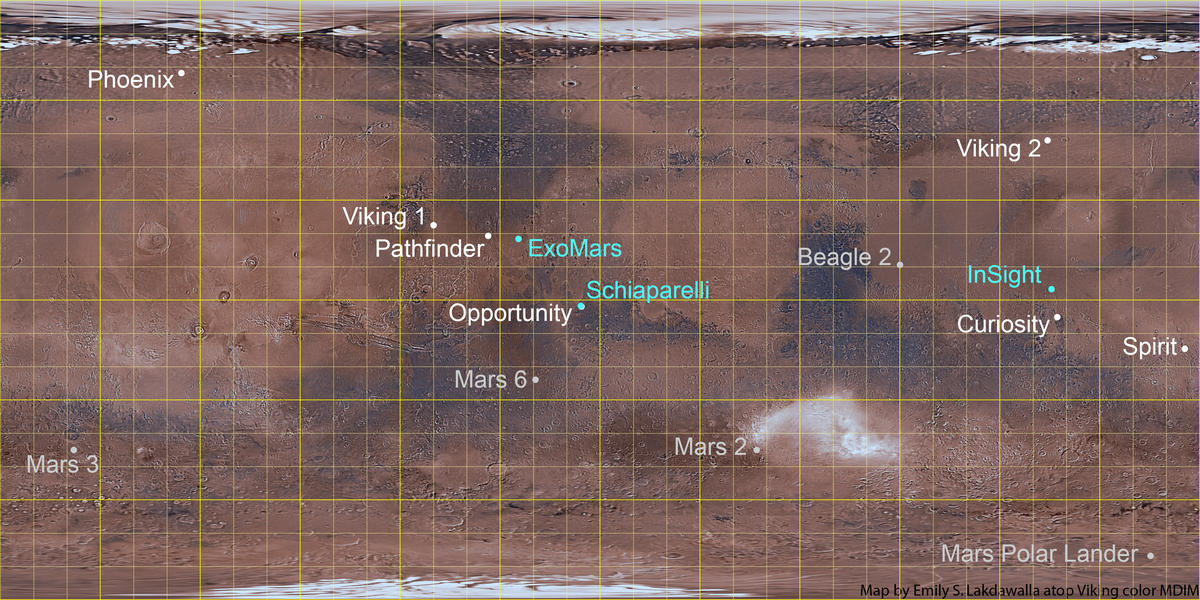
The blue color indicates the unsuccessful
Schiaparelli mission and the planned
InSight missions (the landing platform, which must, sowing at the end of 2018, drill a 5-meter well to measure temperature differences) and
ExoMars (rover, to be delivered to Mars by mid-2020).
The theory about the circulation of water in the Martian atmosphere was also confirmed by the images of Viking-2, which showed
frost during the Martian winter:
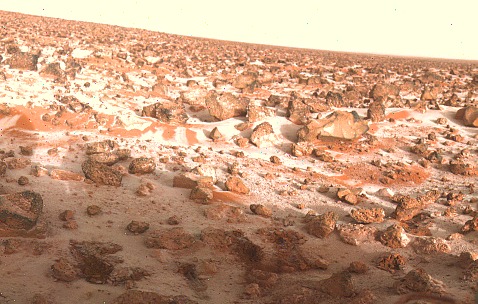
The end of the mission and its legacy
The Viking-2 orbital station worked until July 25, 1978, when it was disconnected due to the exhaustion of all the gas from the orientation system. On April 11, 1980, due to the battery’s failure, its descent vehicle was disconnected, and on August 7 of the same year, gas stopped at the Viking-1 orbital station (although due to its economy, the station was able to work 2 extra years, transferring scientific data in a limited mode). The Viking-1 lander lasted the longest and most likely could continue to work if the wrong commands had not been transferred to the spacecraft, causing it to drop its directional antenna and lose communication with it on November 11, 1982. JPL operators continued unsuccessful attempts to contact him for more than six months, until the Viking mission was declared ended on May 21, 1983.
Color map of Mars with a resolution of 232 meters per pixel
(the original weighs 52 MB)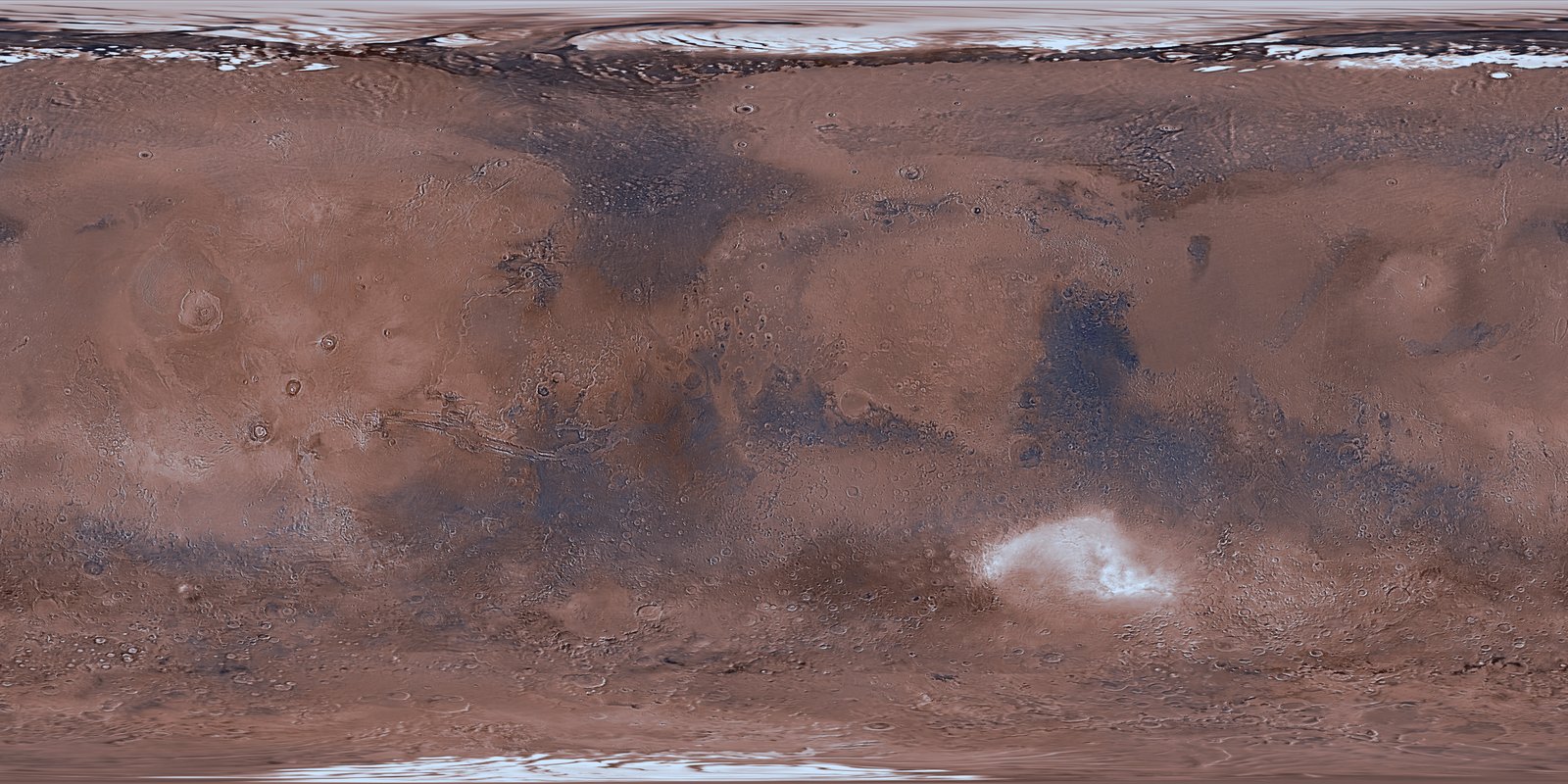
Despite the fact that the latest data from the "Martian Vikings" was obtained 3.5 decades ago, they continue to be fruitfully used and inspire scientists to new achievements until now: only
in 2014, based on the data of the "Vikings", the most detailed the color map of Mars from existing at the moment, and in 2016, the data of the biological experiments of the mission were digitized (which until then had been stored on microfilm):
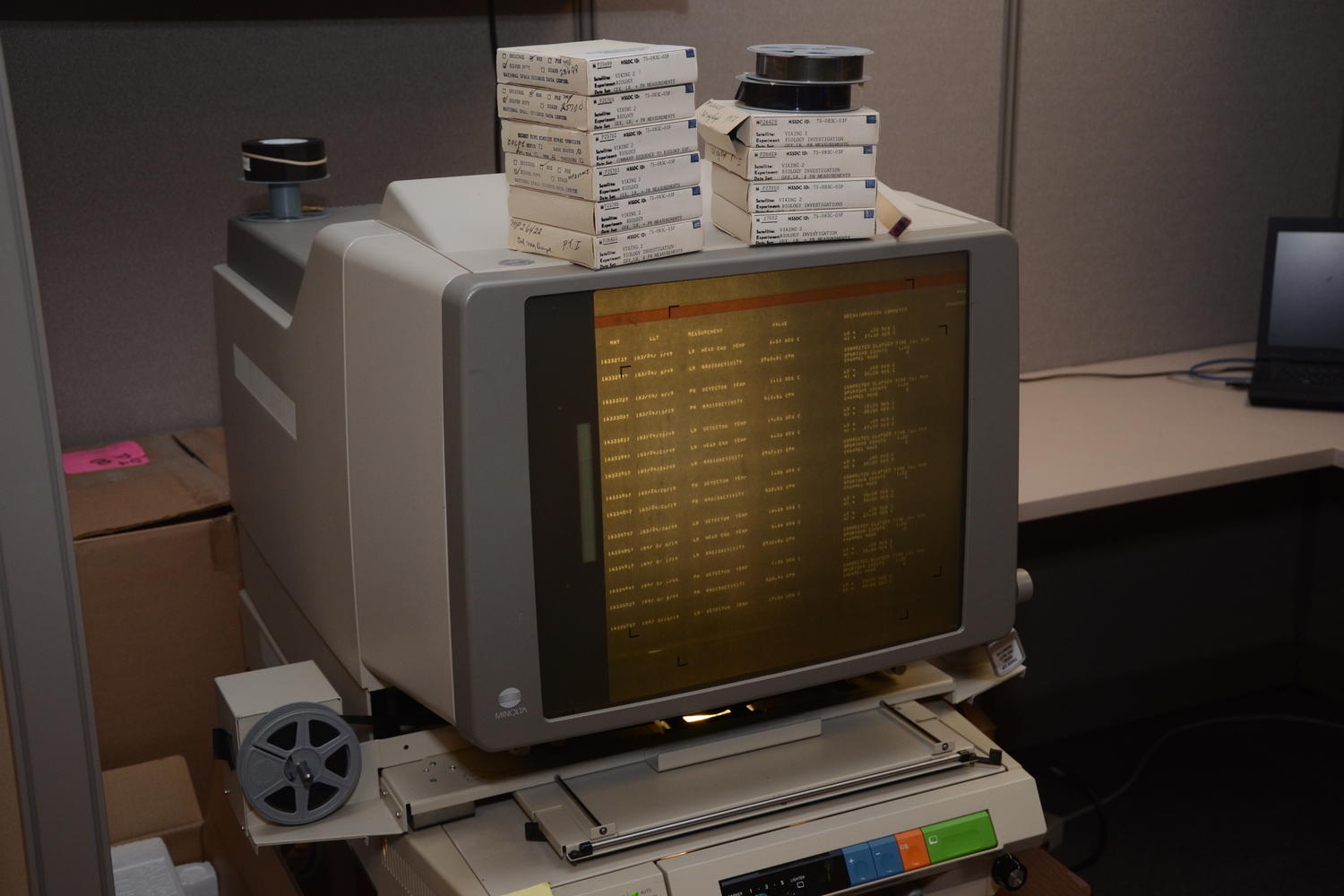
And so the Deputy Director for Science Strategy of the NASA Research Department in Goddart and project manager for the SAM SAM
Curiosity Danny Glavin spoke about the mission:
“We built SAM on the basis of the vast experience and heritage of the Vikings. The capabilities of the descent apparatus of the Vikings and their tools were very advanced at that time. Even the very implementation of a successful landing on the Martian surface was a great feat. ”
Unlike Vikings,
Curiosity's experimental data is now immediately uploaded to the NASA
Planetary Data System to increase its availability.
Links
Mission
OverviewDiscoveries made by devices
Machine dataChapters from the book “On Mars: Exploring the Red Planet. 1958-1978